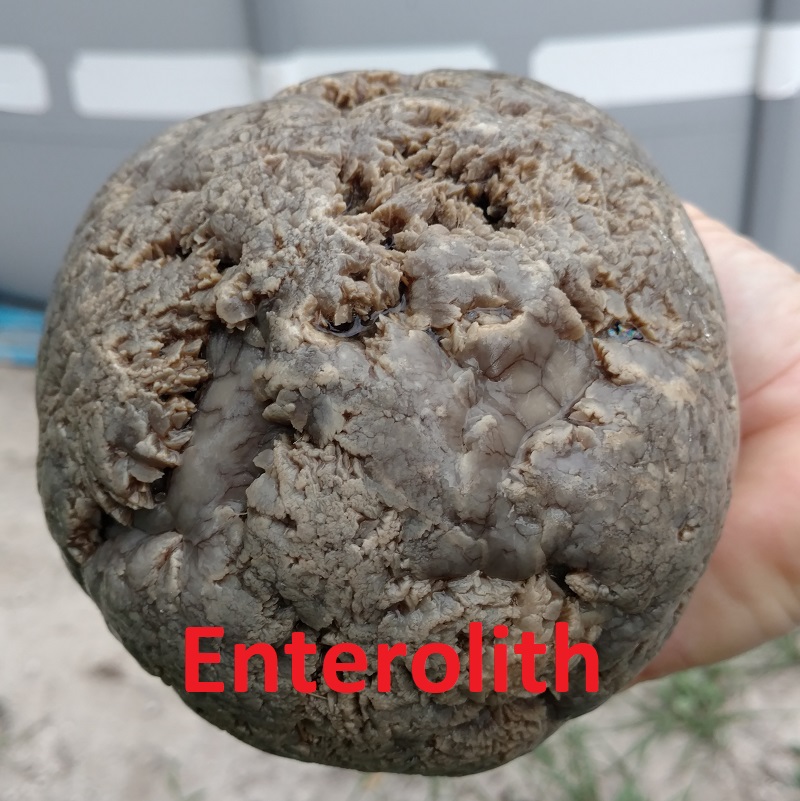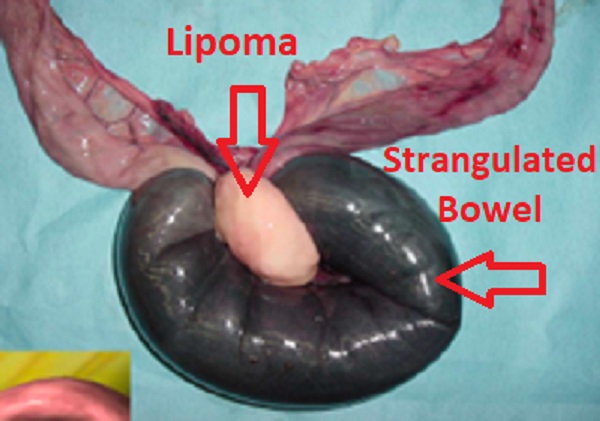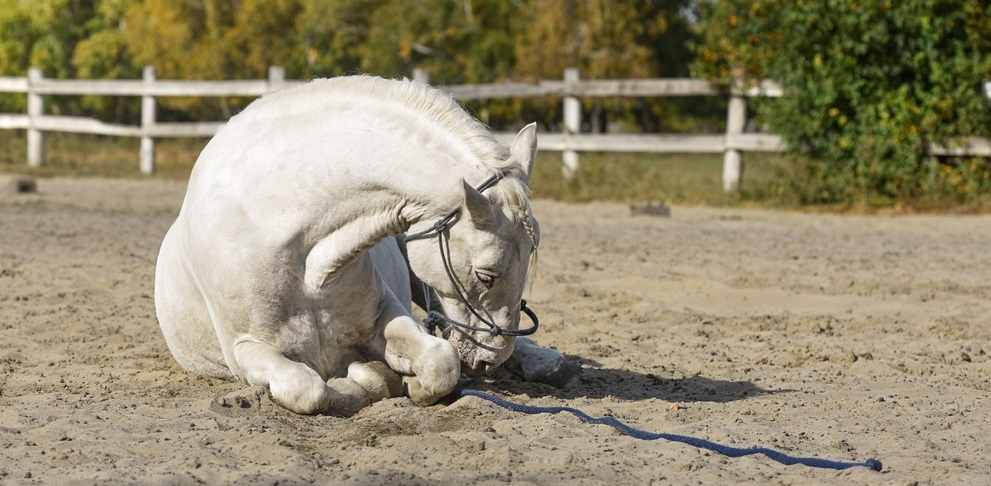Tuesdays with Tony
While a rose is a rose is a rose, a colic is not a colic is not a colic! The old saying implies that when all is said and done, a thing is what it is, but colic in horses isn’t really just one thing. Colic is a catch-all term for abdominal pain, but a number of issues might be going on in that dark mysterious place that is your horse’s belly. While the outward signs can look similar (rolling, pawing, lack of interest in food, etc.) it takes some detective work in my doc’s examination to determine the cause of your horse’s colic.
Depending on what the actual problem is, the treatment can be very different. It can be confusing to horse owners that the remedy that worked on their horse before isn’t the right choice for the colic they’re dealing with now. I’ve written several blogs filled with my cat wisdom on how to prevent colic, but today let’s talk about the different kinds of colic so you can have a better understanding of what my doc is describing if a colic happens.
There are a few broad categories of colic – non-strangulating obstructions, strangulating obstructions, inflammatory conditions, and “other stuff” that doesn’t really fit into those other categories. There are about 100 feet of intestine in your horse’s belly, so unfortunately there’s a lot that can go wrong. I won’t describe every possible abdominal problem your horse could think up, because frankly we’d be here all day and I have a clinic to supervise!
Non-Strangulating Obstructions
This is the largest category of colic my docs see. In these types of obstructions, something is blocking the passage of feed material through the GI tract. Because the blood supply to the gut isn’t cut off (aka strangled), the intestinal tissue isn’t badly damaged (at least not immediately). Non-strangulating colic can often be managed medically, meaning that with appropriate care such as pain medications, oral or intravenous fluids, and laxatives, many can get better without surgery.
The type of non-strangulating obstruction you’re probably most familiar with is a feed impaction. It’s basically constipation. Food gets lodged somewhere in the GI tract – frequently the large colon or a part of the small intestine called the ileum. We see impactions a lot when the horse isn’t drinking enough water and gets dehydrated, when he’s not chewing his feed well, or with certain types of feed (cough-cough coastal hay cough) Most of the time, if my docs can rehydrate your horse and soften the impaction, she can get him un-impacted and feeling better.
Also very common are large colon displacements. The not-so-brilliant design of the horse GI tract includes a 12-foot-long large colon that basically has a single attachment point to the upper body wall. Why is that a problem? Because it allows the colon to move around the abdomen. Sometimes the colon turns in such a way that it kinks off the passage of feed material and gas or gets trapped against other organs. We call this a right dorsal displacement or a left dorsal displacement (aka nephrosplenic entrapment), depending on what direction the colon has moved. Some of these can be treated medically, but sometimes the colon will fill up with food and gas and get really wedged. It can get bad enough that the gut becomes damaged, and the horse won’t survive without surgery.

Other kinds of non-strangulating obstructions include sand impactions, which is ingested sand that accumulates in the large colon, and enteroliths, which are mineral stones that develop in the colon and grow large enough to cause a blockage. Enteroliths can require surgery to remove if they get large enough to cause a problem. Young horses that aren’t dewormed properly can even develop an obstruction made of ascarid parasites.
Strangulating Obstructions
Thankfully, strangulating obstructions aren’t as common as the non-strangulating types, but when they do happen, you have to move fast to save the horse’s life. These colics occur when part of the GI tract gets twisted or trapped in a way that cuts off the blood supply to the gut. Strangulating colics are much more serious and always require surgery to treat.
Signs of pain often come on quite suddenly and can be quite severe, with a very high heart rate and violent rolling. It’s usually difficult or impossible to control the horse’s pain with medications. The bowel begins to die quickly once the blood supply is cut off, so there’s no time to lose and your horse will need to be on his way into surgery quickly. Yet another reason to contact your vet immediately if your horse is showing signs of colic.
There are several types of strangulating colic. A “volvulus” of the large or small intestine occurs when the piece of bowel twists on its own axis and tightens down. Because of the long attachments and the ability of the bowel to move around the abdomen, volvulus can occur as an “accident” for no known reason. Large colon volvulus also tends to occur in broodmares shortly after foaling.
Another common strangulating lesion, especially in older horses in their later teens and 20’s, is a lipoma. A lipoma is a benign fatty tumor growing from the mesentery (the tissue that connects the intestine). The lipoma itself isn’t the problem, it’s the fact that the lipoma grows suspended from a thin rope of tissue like a stalk. Lipomas can exist in the abdomen for years without causing an issue, but if they get wrapped around the intestine, they will quickly cause the tissue to die. The treatment is surgical removal of the dead intestine and suturing the healthy ends of intestine together.

Entrapment colic occurs when small intestine gets stuck in a place where it’s not supposed to be. Epiploic foramen entrapment is when the intestine wiggles itself into a narrow opening between organs in the front of the abdomen, called the epiploic foramen. The foramen is a normal part of the horse’s anatomy, but the intestine isn’t meant to get in there. Another way entrapments happen is through an abnormal tear in the mesentery (a mesenteric rent) or in the gastrosplenic ligament. In both cases, there is an abnormal opening where there isn’t supposed to be one, and the intestine finds its way in there and gets stuck.
An intussusception is a weird type of colic where a piece of intestine telescopes inside the adjacent intestine and gets stuck. It’s an infrequent cause of colic and tends to affect young horses. Eventually, like all strangulations, the blood supply is cut off and the bowel starts to die.
The prognosis for a strangulating colic depends on how long the colic has been going on, how much intestine is involved, and how quickly the horse is operated on. While strangulating colics are invariably very serious situations, if treatment is performed fast, many will make it through surgery and be discharged home.
Inflammatory
Inflammatory colics are usually caused by infection by bacteria, viruses, or mold. Sometimes it’s possible to find the specific microorganism causing the problem, like salmonella or clostridium, but frequently the exact cause can’t be identified. Inflammatory colics can involve the large colon (colitis), small intestine (enteritis), or the peritoneal space inside the abdomen that contains the organs (peritonitis). Unlike most of the other types of colic we’ve discussed, inflammatory colics may have a fever.
They can all range from relatively mild to extremely severe. The inflammation of the colon in a colitis case usually results in diarrhea. Enteritis causes inflammation of the small intestine and a painful fluid backup in the stomach and small intestine. Peritonitis cases might show obvious colic signs, or just depression and a lack of appetite. Depending on what kind of inflammatory colic you’re dealing with, the treatment might be intravenous fluids, antibiotics, decompression of the stomach by nasogastric tube, or lavage of the peritoneal space. Prognosis depends on the amount of inflammation and how sick the horse is.

Other Stuff
There are a few other types of colic that don’t fit easily into one of the categories above. And it’s not that they’re uncommon! Gas colic, sometimes called spasmodic colic, is one of the most common causes of abdominal pain in horses. Gas buildup in the intestine can be caused by changes in diet or activity level, though many times a specific reason can’t be identified. While many gas colics will feel better once the gas moves through, it’s possible for an untreated gas colic to progress into a more serious colon displacement or twist.
Gastric ulcers, or sores in the lining of the horse’s stomach, don’t always show obvious outward signs – they may just have poor body condition, lack of appetite, or attitude changes. More serious cases can show colic signs like laying down and grinding their teeth. They can affect any horse at any age, but they’re most likely to occur in athletes like race or show horses.
As you can see, there are a whole bunch of different ways your horse can colic! It’s not possible to tell the type of colic just by looking at it, so make sure to get my docs involved right away. That’s why they go to school for years and years!
I’m going to give you a Pro Tip from a cat in the know: I see people who are trying to avoid spending $500 on a vet bill when their horse is showing signs of colic, so they try to wait it out. The first few hours that the horse is sick is when it’s the cheapest and easiest to treat him. After that, it gets more expensive, and the chances of a good outcome drop significantly, because most of these things we’ve talked about get worse if left alone, not better. So do your horse (and your wallet) a favor and call sooner rather than later.
Until next week,
~ Tony
P.S. Now that I’ve whetted your appetite with some serious horse knowledge, you should listen to an episode of Straight from the Horse Doctor’s Mouth, which is my podcast. Well, I have people that do that stuff, just to be clear, but I still claim it. Dr. Lacher is willing to spend way more time talking about this than I am (hey, a cat’s got to sleep, and eat, and there’s only so many hours in the day). She has several very in-depth episodes on colic that will really clog your brain up with next-level facts. You can check it out over on the Podcast Page, or subscribe on Apple Podcasts, Spotify, or wherever you get your podcasts.
Tuesdays with Tony is the official blog of Tony the Clinic Cat at Springhill Equine Veterinary Clinic in Newberry, Florida. If you liked this blog, please subscribe below, and share it with your friends on social media! For more information, please call us at (352) 472-1620, visit our website at SpringhillEquine.com, or follow us on Facebook!
[jetpack_subscription_form title="Subscribe to Whinny's Wisdoms"]

